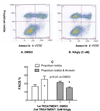Resolution of inflammation by N-arachidonoylglycine
- PMID: 21732409
- PMCID: PMC3196844
- DOI: 10.1002/jcb.23245
Resolution of inflammation by N-arachidonoylglycine
Abstract
N-arachidonoylglycine (NAgly) is an endogenous signaling lipid that is a member of the eicosanoid super family and is related to anandamide. It shows anti-inflammatory activity in vivo in the mouse peritonitis model where it reduces migration of inflammatory leukocytes following injection of pro-inflammatory agents into the peritoneal cavity. Using cell culture models, including GPR18 transfected HEK-293 cells, evidence is presented that the orphan receptor GPR18 is involved in this action. Increases in free arachidonic acid, and robust stimulation of anti-inflammatory eicosanoids were observed at low micromolar concentrations. These included 15-deoxy-delta-13,14-PGJ(2) and lipoxin A(4) both of which are believed to mediate the resolution stage of inflammation. It was further shown that NAgly might act via GPR18 activation in promoting the number of Trypan Blue stained cells, a possible indicator of programmed cell death. Thus, we hypothesize that NAgly induces the death of inflammatory cells, a process that is considered to be important for the resolution of inflammation.
Copyright © 2011 Wiley Periodicals, Inc.
Figures





Similar articles
-
N-arachidonoyl glycine, an abundant endogenous lipid, potently drives directed cellular migration through GPR18, the putative abnormal cannabidiol receptor.BMC Neurosci. 2010 Mar 26;11:44. doi: 10.1186/1471-2202-11-44. BMC Neurosci. 2010. PMID: 20346144 Free PMC article.
-
N-arachidonoyl glycine induces macrophage apoptosis via GPR18.Biochem Biophys Res Commun. 2012 Feb 10;418(2):366-71. doi: 10.1016/j.bbrc.2012.01.027. Epub 2012 Jan 11. Biochem Biophys Res Commun. 2012. PMID: 22266325
-
Identification of N-arachidonylglycine as the endogenous ligand for orphan G-protein-coupled receptor GPR18.Biochem Biophys Res Commun. 2006 Sep 1;347(3):827-32. doi: 10.1016/j.bbrc.2006.06.175. Epub 2006 Jul 10. Biochem Biophys Res Commun. 2006. PMID: 16844083
-
N-Acyl Amino Acids (Elmiric Acids): Endogenous Signaling Molecules with Therapeutic Potential.Mol Pharmacol. 2018 Mar;93(3):228-238. doi: 10.1124/mol.117.110841. Epub 2017 Nov 14. Mol Pharmacol. 2018. PMID: 29138268 Review.
-
Cannabinoids, endocannabinoids, and related analogs in inflammation.AAPS J. 2009 Mar;11(1):109-19. doi: 10.1208/s12248-009-9084-5. Epub 2009 Feb 6. AAPS J. 2009. PMID: 19199042 Free PMC article. Review.
Cited by
-
Protective Effect of N-Arachidonoyl Glycine-GPR18 Signaling after Excitotoxical Lesion in Murine Organotypic Hippocampal Slice Cultures.Int J Mol Sci. 2019 Mar 13;20(6):1266. doi: 10.3390/ijms20061266. Int J Mol Sci. 2019. PMID: 30871175 Free PMC article.
-
N-FATTY ACYLGLYCINES: UNDERAPPRECIATED ENDOCANNABINOID-LIKE FATTY ACID AMIDES?J Biol Nat. 2017;8(4):156-165. Epub 2018 Mar 3. J Biol Nat. 2017. PMID: 29607420 Free PMC article.
-
Asymmetric synthesis of novel N-(1-phenyl-2,3-dihydroxypropyl)arachidonylamides and evaluation of their anti-inflammatory activity.Life Sci. 2013 Mar 19;92(8-9):506-11. doi: 10.1016/j.lfs.2012.06.040. Epub 2012 Jul 20. Life Sci. 2013. PMID: 22820546 Free PMC article.
-
The resolution of inflammation.Nat Rev Immunol. 2013 Jan;13(1):59-66. doi: 10.1038/nri3362. Epub 2012 Nov 30. Nat Rev Immunol. 2013. PMID: 23197111 Review.
-
Some Prospective Alternatives for Treating Pain: The Endocannabinoid System and Its Putative Receptors GPR18 and GPR55.Front Pharmacol. 2019 Jan 8;9:1496. doi: 10.3389/fphar.2018.01496. eCollection 2018. Front Pharmacol. 2019. PMID: 30670965 Free PMC article. Review.
References
-
- Burstein SMA, Pearson W, Rooney T, Yagen B, Zipkin R, Zurier A. Studies with analogs of anandamide and indomethacin.editor^editors; Symposium on Cannabinoids; Burlington, VT: International Cannabinoid Research Society; 1997. p. 31.
Publication types
MeSH terms
Substances
Grants and funding
LinkOut - more resources
Full Text Sources
Other Literature Sources
Molecular Biology Databases
Miscellaneous

